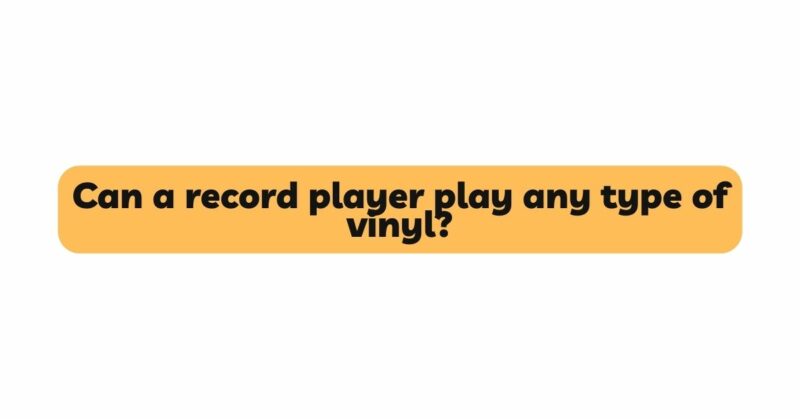Vinyl records, with their timeless appeal and analog warmth, have reclaimed their place in the hearts of music lovers, from nostalgic collectors to contemporary audiophiles. As the vinyl revival continues, a fundamental question emerges: can a record player play any type of vinyl? While record players are designed to accommodate a range of vinyl formats, sizes, and speeds, the intricacies of groove characteristics, stylus types, playback speeds, and even special editions introduce a layer of complexity to vinyl compatibility. This article delves into the nuances of vinyl compatibility, exploring the interaction between record players and the various types of vinyl records they encounter.
The Versatility of Record Players: A Multifaceted Approach
Record players, also known as turntables, are engineered with a degree of versatility to accommodate various types of vinyl records. However, this versatility is not universal, as the design and features of a record player can influence its compatibility with different vinyl formats. Record players are generally designed to play three main vinyl formats: 12-inch LPs (Long Play), 7-inch singles, and 10-inch records. The playback speed of a record player is typically switchable between 33 1/3 RPM and 45 RPM, ensuring compatibility with the standard playback speeds of most records.
Groove Characteristics and Stylus Types: Precision Matters
The intricate grooves etched onto vinyl records carry the audio information that brings music to life. The depth, width, and arrangement of these grooves vary based on the frequency content and dynamics of the music. Stylus types, which come in shapes like conical, elliptical, and microline, are designed to match specific groove characteristics. To ensure accurate tracking and optimal playback, it’s crucial to match the stylus type to the groove profile of the record. Using an incompatible stylus can lead to poor sound quality, excessive wear on the record, and potential damage to both the stylus and the grooves.
Size and Effective Length: A Consideration of Dimensions
The size of a vinyl record plays a significant role in determining its compatibility with a record player. Most record players are designed to accommodate 12-inch LPs, the standard size for albums. However, the effective length of the tonearm, which is the distance from the pivot point to the stylus, must match the size of the record being played. Tonearms with adjustable effective lengths offer greater flexibility in playing different-sized records, including 7-inch singles and 10-inch records.
Playback Speeds: A Question of Revolutions Per Minute
Vinyl records are typically played at two standard speeds: 33 1/3 RPM (revolutions per minute) for LPs and 45 RPM for 7-inch singles. Modern record players are equipped with switches or controls that allow users to select between these playback speeds. Ensuring that the player’s speed settings match the record being played is essential for accurate playback. Some record players might have only one fixed speed, which can limit their compatibility with certain record formats.
Special Editions and Non-Standard Vinyl: Navigating Uncharted Territories
While traditional black vinyl records are the norm, special editions and non-standard vinyl introduce unique challenges to compatibility. Picture discs, for example, feature images embedded in the vinyl, which can affect the stylus’ ability to accurately track the grooves. Colored vinyl, if not produced with high-quality materials, can introduce additional noise due to uneven color distribution. Non-standard vinyl sizes and shapes, such as square or triangular records, may require specialized equipment for accurate playback.
Tonearm Weight and Counterbalance: Balancing Act
The weight of the tonearm and the counterbalance settings play a crucial role in preserving both the record and the stylus. The tonearm weight, applied to the stylus, must be appropriate for the specific stylus and record being played. An inadequate weight can lead to poor tracking, while excessive weight can cause premature wear. Proper counterbalance adjustments ensure that the stylus exerts the right amount of pressure on the grooves, optimizing playback quality and longevity.
Proper Handling and Maintenance: Safeguarding the Experience
In addition to considering format compatibility, proper handling and maintenance practices are essential for both records and equipment. Regular cleaning, storing records vertically, and using anti-static brushes contribute to the longevity of the record and the stylus. Cleaning the stylus regularly prevents the buildup of debris that can affect playback quality. Ensuring that records are kept clean and free from dust ensures a superior listening experience.
Conclusion
The world of record players and vinyl records is a dynamic interplay of technology, craftsmanship, and artistry. While record players are designed with versatility to accommodate various vinyl formats and sizes, the intricacies of stylus types, groove characteristics, playback speeds, and special editions introduce a layer of complexity to compatibility. As enthusiasts embrace the resurgence of vinyl, understanding the nuances of vinyl compatibility enhances the appreciation of the analog experience. Whether indulging in the warmth of a 12-inch LP or savoring the energy of a 7-inch single, the harmony between record players and vinyl records brings the music to life, capturing the spirit of a bygone era in a world that continues to evolve.


